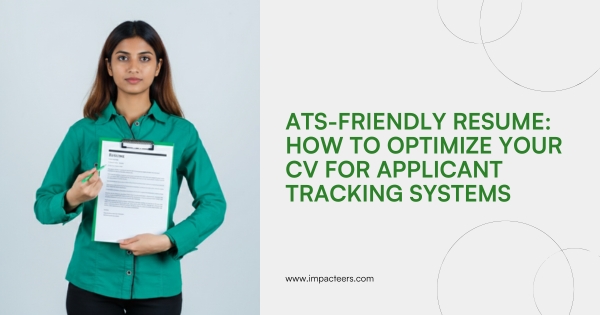Introduction: Why ATS Resumes Are Important Now
Picture this: you spend hours working on your ATS resume, send it to your dream company, and hear nothing back. No calls, no interview,just silence. It might feel like recruiters are ignoring you, but chances are your application never even reached them.

What’s the reason? Applicant tracking systems (ATS)—the software that screens resumes. These days most medium and large companies rely on ATS to process job applications. If your resume doesn’t follow ATS rules, it gets blocked before any recruiter has the chance to read it.
Visit Us >>> https://www.impacteers.com
Crafting an ATS resume plays a crucial role when your goal is to land a job. This guide will explain how ATS functions, the errors that often hold candidates back, and the key resume strategies you need to create a CV that both navigates ATS systems and catches the attention of hiring managers.
What is an ATS Resume?
Getting to Know Applicant Tracking Systems
An ATS, or Applicant Tracking System, is a tool employers use to organize job applications. Instead of sorting through piles of resumes by hand, recruiters depend on ATS software to scan, organize, and rank these resumes .
Wikipedia states that over 95% of Fortune 500 companies rely on ATS technology. If you’re aiming for competitive jobs, there’s a good chance an algorithm reviews your application before a person does.
Why Companies Use ATS to Hire
Recruiters deal with hundreds or sometimes thousands of resumes for just one job opening. It isn’t practical to go through them all by hand. ATS speeds things up and ensures the strongest applications land in front of hiring managers.
This creates both hurdles and advantages for job seekers. You can increase your chances of getting noticed bypassing these automated systems, with a well-optimized CV.
How ATS Fits Into Hiring
To outsmart robots, you should first learn their game. Here’s a step-by-step guide on how an ATS (Applicant Tracking System) looks through applications:
Looking for Keywords
ATS checks resumes for specific terms found in the job posting. If the job asks for “Python programming” and those exact words aren’t in your resume, ATS might pass over your application—even if you have that skill.
Breaking Down Resumes
It organizes resumes into sections like contact info, education, work experience, and skills. If your layout uses things like columns, images, or tables, the system might not process it .
Scoring and Selecting
Once the resume is broken down, ATS scores it by how well it matches the job’s keywords and needs. the top-scoring resumes make it to a recruiter’s desk.
The bottom line? If you don’t customize your ATS resume, you reduce your chances of moving ahead.
Biggest Challenges People Face with ATS
Why Good Candidates Get Turned Down
ATS systems reject plenty of skilled people . This doesn’t happen because they don’t have the abilities. It happens because their resumes aren’t designed to pass through digital scanners.
Resume Errors That Fail ATS
These mistakes make resumes disappear during the ATS process:
- Adding graphics or tables
- Sending the wrong type of file
- Leaving out job-specific keywords
- Overloading with keywords in an unnatural way
- Vague headings like “My Story” instead of something clear like “Work Experience.”
Avoiding these mistakes helps you create a resume that works well with ATS.
Resume Suggestions: Ways to Improve ATS Performance
To make sure your resume gets through the ATS screening, try these trusted strategies:
Add the Right Keywords
Look at the job description. Highlight the important skills, tools, and qualifications they want, and include them in your resume. For instance:
Bad: “Handled clients using software tools.” Better: “Managed client accounts using Salesforce CRM.”
Pick the Correct File Format
Most ATS systems work with .docx files or basic PDFs. If the job ad does not suggest a different format, choose one of these.
Keep It Simple and Easy to Read
Pick common fonts like Arial, Calibri, or Times New Roman. Use clear sections like Work Experience, Education, and Skills for better organization.
Skip Graphics and Tables
Graphics, logos, or tables cannot be read by ATS systems. Stick with plain text and use bullet points.
Adjust Your Resume for Every Job
Do not use the same resume for all jobs. Edit it to match the specific role by adding relevant keywords and emphasizing related skills or past work.
How to Craft an ATS-Friendly Resume
Here’s a simple guide to help you create a resume that works well with both ATS systems and recruiters.
**1. Organize Sections **
Start by using these section names:
- Contact Information
- Professional Summary
- Skills
- Work Experience
- Education
- Certifications
2. Crafting a Professional Summary
Skip generic objectives. Focus on a short sharp summary of your key strengths. For example: “A marketing graduate with a detail-focused mindset skilled in SEO, content strategies, and data analysis aiming to drive digital growth projects.”
3. Presenting Skills Effectively
Separate your skills into technical and personal ones. Example:
- Technical Skills: Proficient in Python SQL, Google Analytics, and Salesforce
- Valued Skills: Leadership working in teams, finding and solving problems
4. Highlighting Achievements Using Data
Employers like results they can measure. Say something like, “Grew social media engagement by 45% with focused campaigns.”
5. Listing Courses and Certifications
Include training programs online classes, or certifications that matter for the job.
Making CVs Different from Resumes
How CVs and Resumes Vary by Region
- In the US, a resume is short—1–2 pages and tailored to the job.
- In Europe and Asia, CV often refers to a longer more detailed write-up.
What Recruiters Look For With Each
No matter where you are, ATS works the same way. It looks for keywords, analyzes information, and ranks applicants.
Resume Tips by Industry
Here’s how you can change your resume to match certain careers:
IT and Software Development
- Mention coding languages like Python, SQL, and Java.
- Talk about projects such as app creation or moving systems to the cloud.
- List certifications like Azure or AWS.
Business and Management
- Show leadership positions from internships.
- Add tools like SAP, Excel, or Power BI.
- Focus on results like saving money or boosting efficiency.
Marketing and Sales
- Include tools such as SEMrush, Google Ads, or HubSpot.
- Use numbers to show results. For example: “Boosted lead conversions by 30%”
- Talk about your experience managing campaigns.
Healthcare and Medical Jobs
- Include things like lab research, certifications, or clinical rotations.
- Show that you understand patient care and compliance guidelines.
Graduates and Entry-Level Job Seekers
- Focus on your studies, internships, and any projects you worked on.
- Mention skills like teamwork clear communication, and being flexible.
Professional Resume Assistance: When to Seek Help
Sometimes, you need to ask for help to get your resume right.
Online Resume Tools
Sites like Canva or Zety offer templates that work well with applicant tracking systems.
Career Coaches or Resume Experts
Getting a pro to help can make sure your resume suits the industry you are applying for.
Ways to Check If Your Resume Works with ATS
Free ATS Checkers Online
Sites like Jobscan let users paste both their resume and the job description to measure how well they match.
Paid Tools to Improve Resumes
Paid options give keyword ideas and tips on formatting to help resumes rank higher.
Tips to Create an ATS-Friendly Resume
What You Should Do
- Stick to standard headings
- Match the job description keywords
- Save the file as a .docx unless told
- Limit the resume to one or two pages
What You Should Avoid
- Avoid fancy fonts or layouts
- Explain any gaps in your work history
- Skip unnecessary or unrelated details in your resume
Career Tips: Thinking Beyond the ATS
An ATS-optimized resume is important, but relying on resumes won’t work.
Using Networking to Strengthen Job Applications
Join industry gatherings, alumni reunions, or online webinars. Referrals let you avoid dealing with the ATS.
Maximizing LinkedIn in Your Job Hunt
Recruiters use LinkedIn as much as they look at resumes. Match your profile with your resume when applying.
Conclusion: Creating an ATS Resume To Help You Land the Job
Your resume opens doors to opportunities, but first, it needs to make it through applicant tracking systems. This guide gives you the tools to create an ATS-friendly resume that gets through those systems and leaves a good impression on recruiters.
Keep this in mind: use the right keywords, stick to simple formatting, and tailor your resume to each role. Pairing these resume strategies with effective networking and a well-maintained LinkedIn profile can boost your chances to land the job you want.
Do not let ATS stand in the way of your goals. Start improving your resume now and move closer to the job you’ve been aiming for!
Learn More >>> https://www.impacteers.com
About Us >>> https://blog.impacteers.com
Common Questions About ATS Resumes
1. What is an ATS resume? It is a resume designed with specific keywords clear structure, and job-focused content to get through applicant tracking systems.
2. What’s the best format to submit an ATS resume? Using .docx is the safest option. If allowed simple PDFs can work too.
3. Can an ATS handle PDFs? Some systems can, but not every ATS does. When in doubt, go with a Word document.
4. Should I add tables or images to my ATS resume? Avoid both. Parsing systems may struggle to read them. Use plain text formatting.
5. How do I check if my resume works with ATS?
Test it using free tools like Jobscan. They match your resume with job descriptions.
6. Is adding a lot of keywords good for ATS resumes?
It’s not a good idea. ATS systems may penalize resumes crammed with forced keywords. Add them .




Post Comment